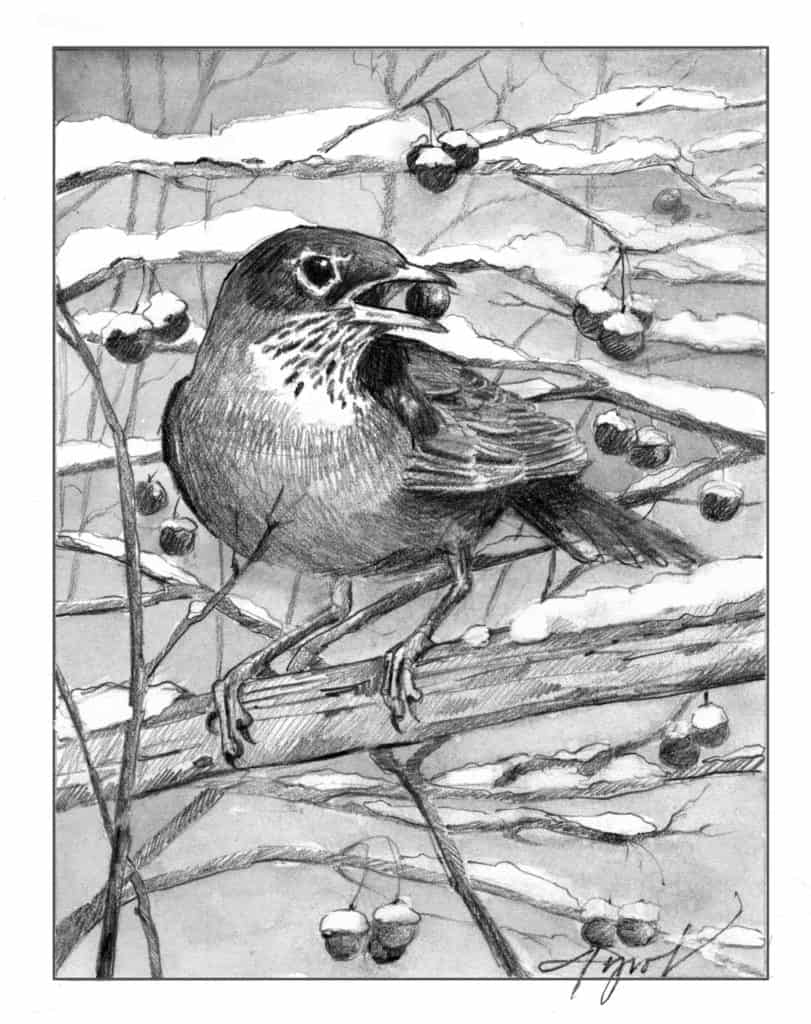
By Susan Shea
Late one January afternoon, my husband and I stood on the shore of a frozen pond below the summit of Camel’s Hump, admiring the view. Suddenly we heard familiar calls, and a flock of robins flew over. Robins? In winter? In the mountains? I was perplexed.
Later, I talked with a birder friend, who informed me that robins from Labrador and other northern regions migrate south to the Green and White Mountains in winter, where they feed on mountain ash berries. Indeed, during our snowshoe trek to the pond, we had noticed clumps of bright red fruit in the small mountain ash trees, topped with powdery snow.
Although the Northeast is not known for winter fruit, according to UVM biology professor emeritus Bernd Heinrich in his book “Winter World,” there are 29 species of berries which ripen in fall and persist on the branch through the winter. Trees and shrubs laden with refrigerated fruit are an important food source for wildlife, especially birds, and can produce some unusual sightings. The only time I’ve ever seen pine grosbeaks was on a cold winter day; the big, olive-green females and rose-colored males were feeding on crabapples in a small tree next to a health clinic. These birds live in Canada’s coniferous forests, but visit our region in years when seeds and wild fruit are scarce there.
Another time, I witnessed a chattering flock of Bohemian waxwings descend on the staghorn sumac trees lining a parking lot in Montpelier to feed on the fuzzy, reddish fruits. Bohemian waxwings, named for their nomadic behavior, are larger than their more familiar cousins, the cedar waxwings, and more colorful, with white and yellow wing marks. Like pine grosbeaks, they reside in boreal forests, but flocks periodically invade the U.S., where they roam about in search of wild fruit.
Bohemian and cedar waxwings are the most frugivorous (fruit-eating) birds in North America. Their stomachs have less musculature and their intestines are shorter than those of birds with a more varied diet. Food passes through the gut quickly, so they can feed rapidly when fruit is available. Flocks of waxwings can make short work of fruit on a tree. You might almost feel sorry for the plant. But plants and birds evolved together, and plants have designed fruit — delicious little packages of pulp — to attract birds and other wildlife, in order to disperse their seeds. Many seeds can survive passage through an animal’s digestive tract and are transported to new places that way.
Fruit pulp is typically rich in carbohydrates and vitamins and the seeds inside are concentrated sources of fat and proteins. However, specific nutritional content depends on the season of dispersal, writes Heinrich. Fruits with a long branch life such as staghorn sumac are more acidic and lower in fat, sugar, and water to prevent spoilage.
Apples, both wild and cultivated, are another fruit popular with wildlife in winter. Check beneath an apple tree and you’re likely to find deer tracks, droppings, and pawings in the snow where the deer have dug up frozen fruit. Coyotes, foxes, fishers, snowshoe hares, red and gray squirrels, grouse, and turkeys will all eat apples in winter. Squirrels will store apples in the crooks of tree branches for future consumption.
This past fall, there was an abundant crop of apples and other fruit and as a consequence, some bears continued feeding and delayed hibernation. While cross-country skiing in early December, I saw bear tracks coming out of the woods and leading to a group of wild apple trees in the back corner of a pasture. The small trees were not strong enough to support the bear, so it had pulled down several branches to reach the apples. The following day, I skied by a porcupine feeding in one of the apple trees.
Planting native fruit-bearing trees and shrubs is a great way to provide food for birds and other wildlife in winter. Some good choices are mountain ash and the three viburnums: nannyberry, high-bush “cranberry,” and maple-leaved arrowwood. Staghorn sumac often sprouts naturally, and is considered a “weed tree” by many. But it is valuable for birds as its fruits last up to eight months and provide food in late winter and early spring when few other berries are available. Sumac fruits are consumed by returning migrants such as flickers and catbirds.
Flocks of birds feeding on winter fruit in your yard are sure to brighten up a cold, gray day.
Susan Shea is a naturalist, writer, and conservation consultant who lives in Brookfield, Vermont. The illustration for this column was drawn by Adelaide Tyrol. The Outside Story is assigned and edited by Northern Woodlands magazine (northernwoodlands.org) and sponsored by the Wellborn Ecology Fund of New Hampshire Charitable Foundation ([email protected]).




